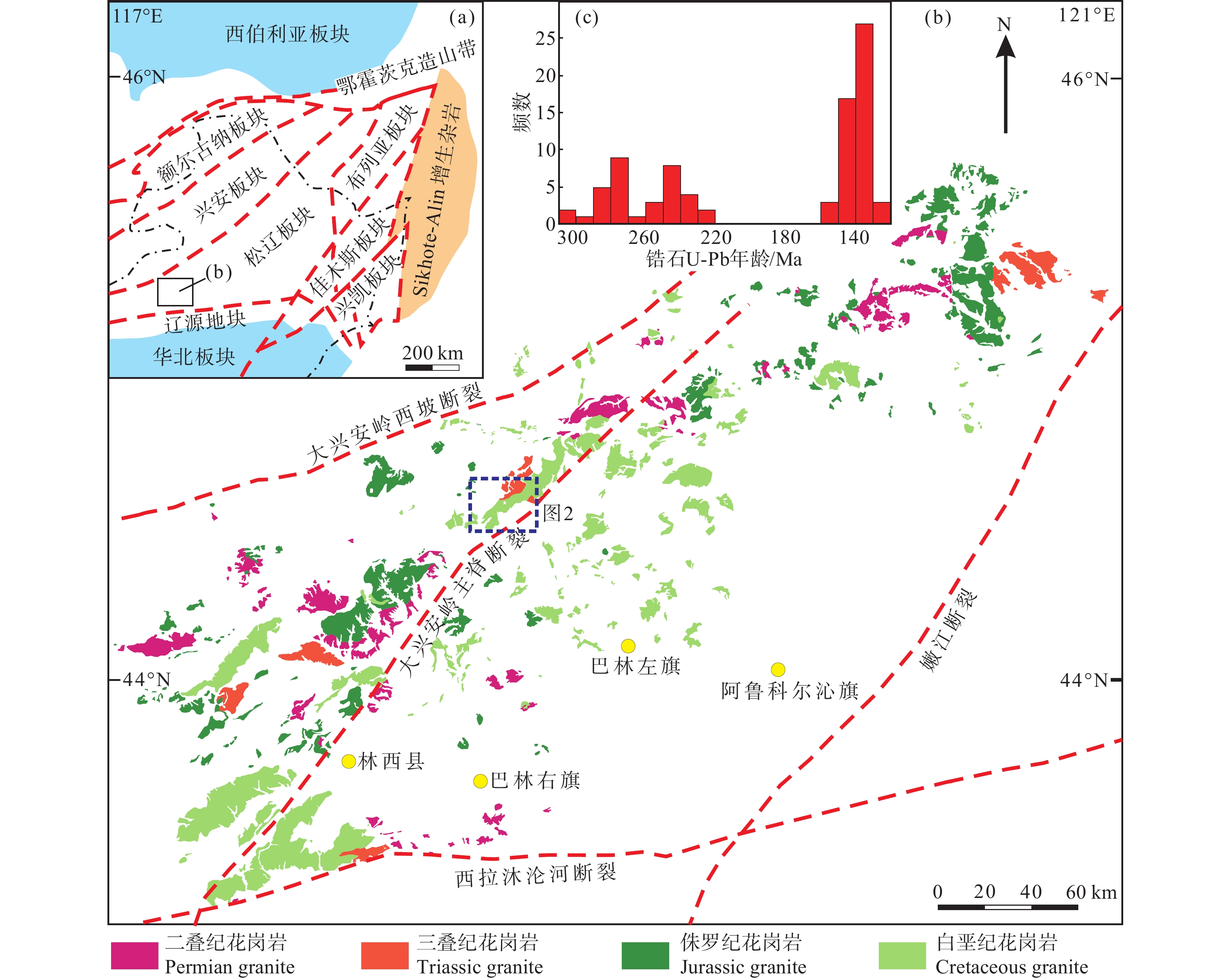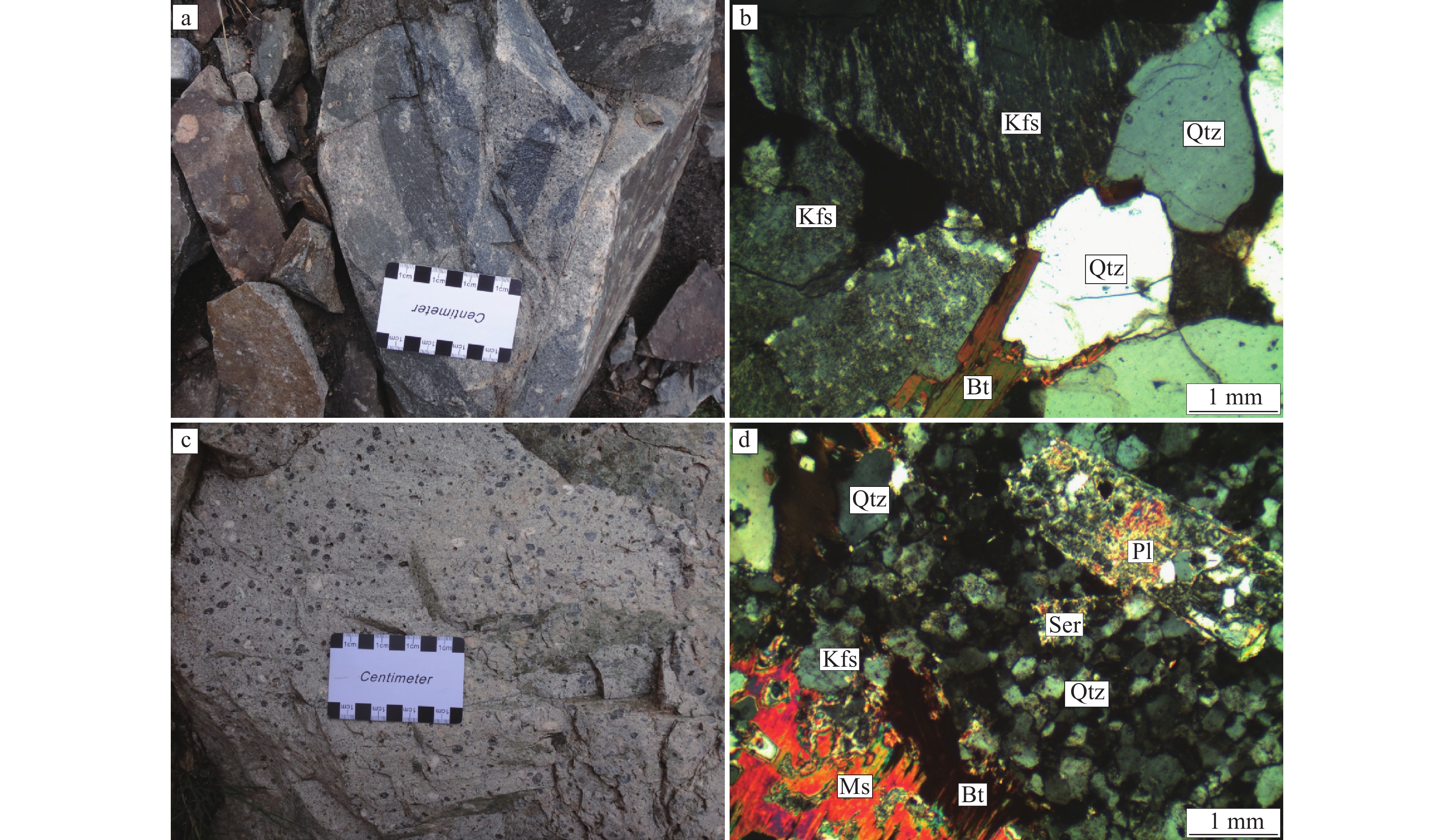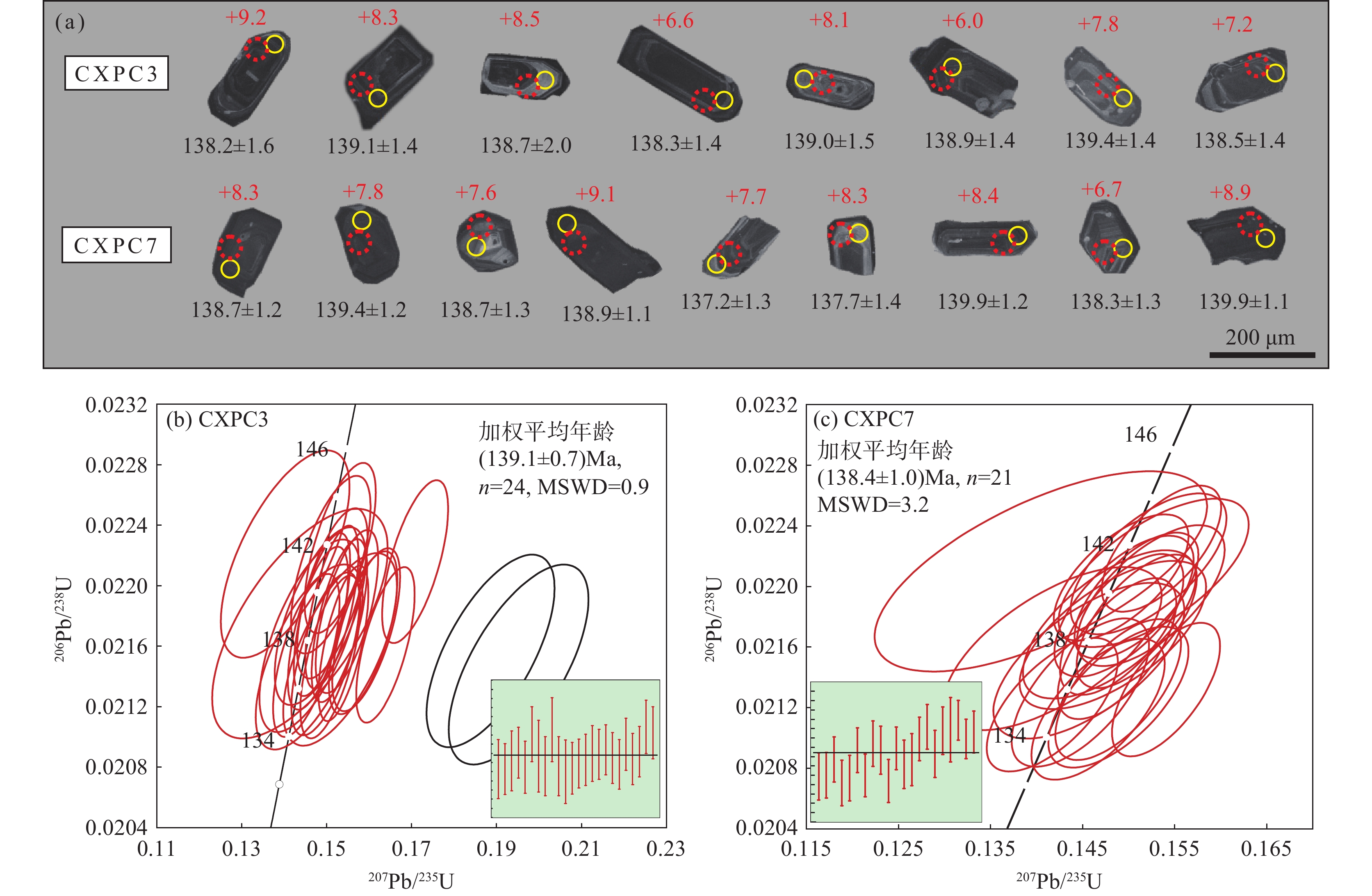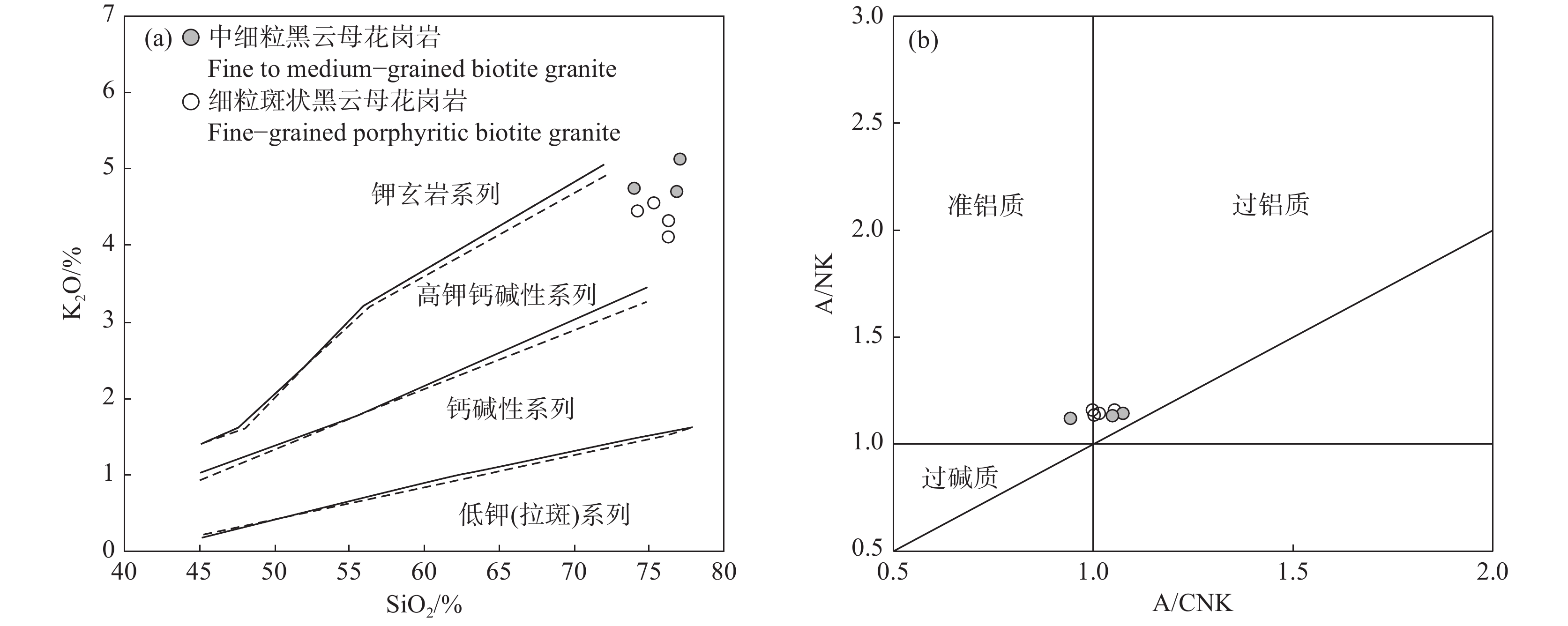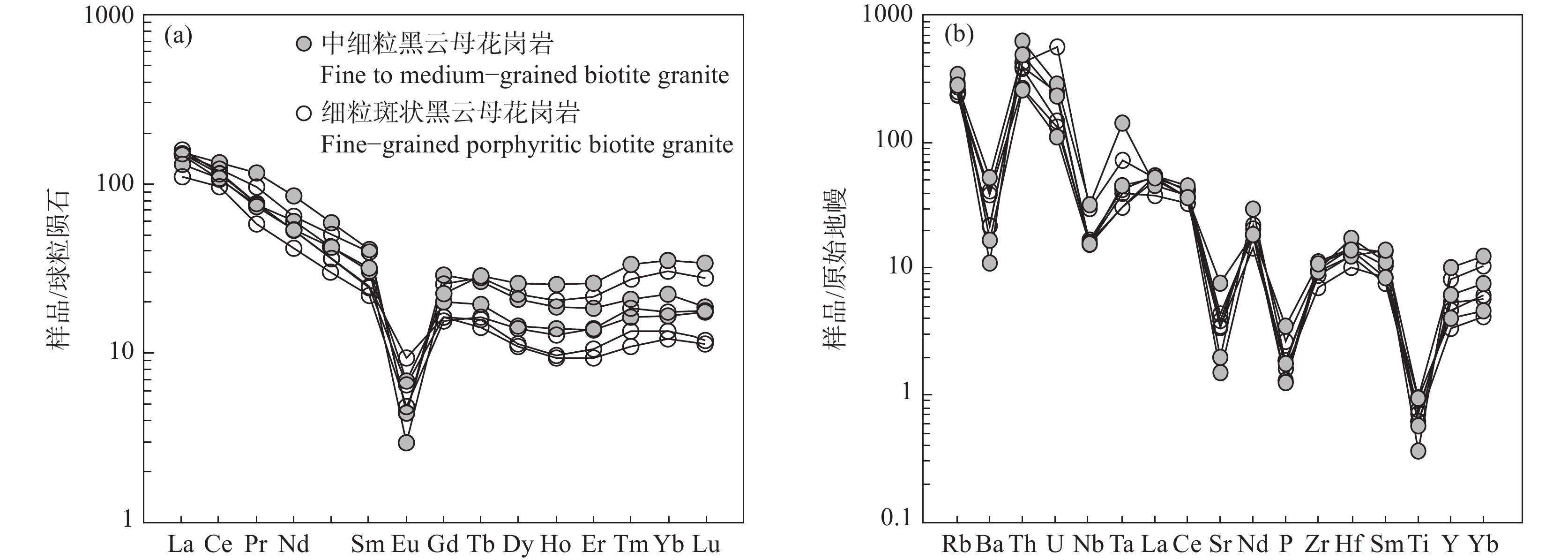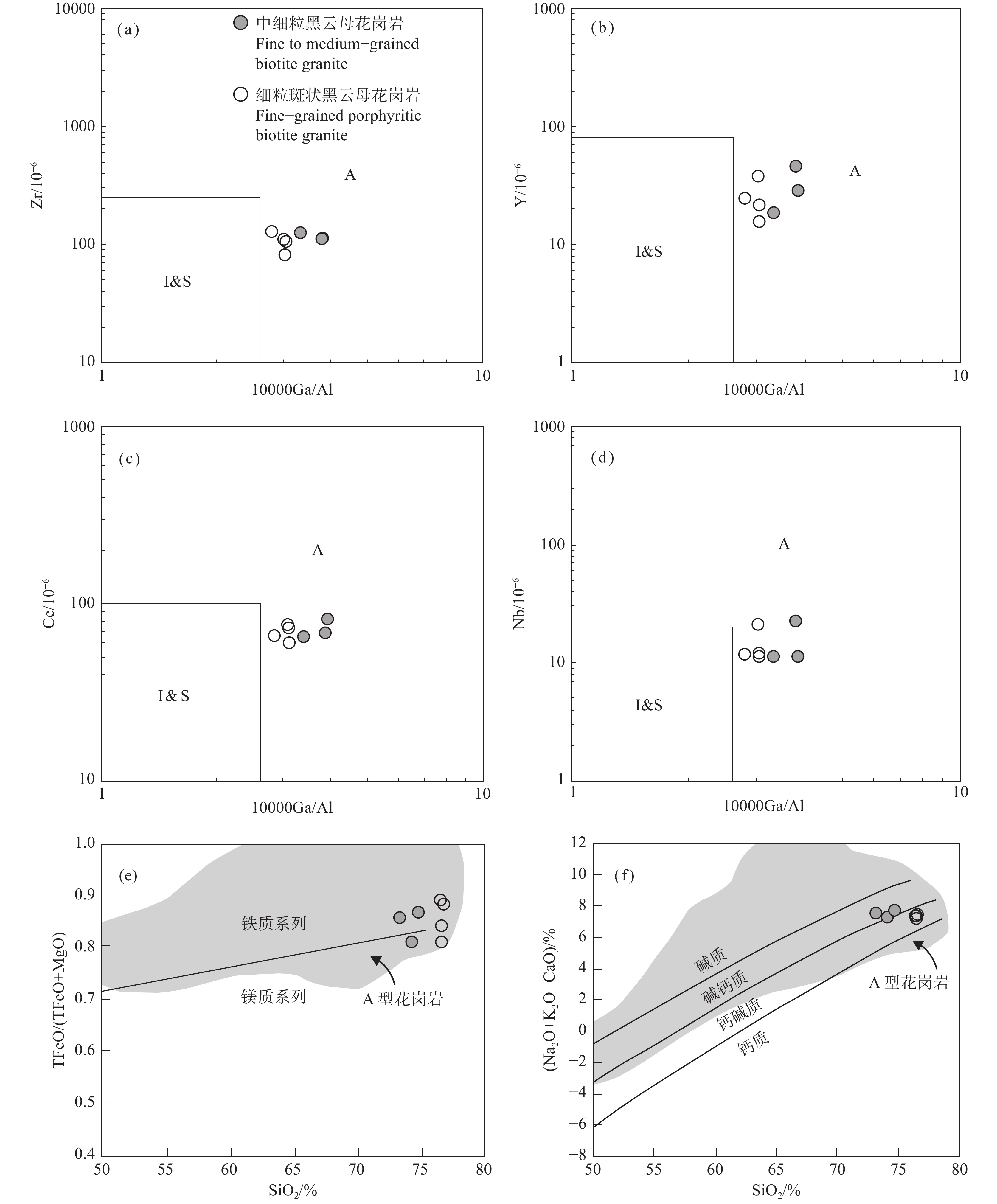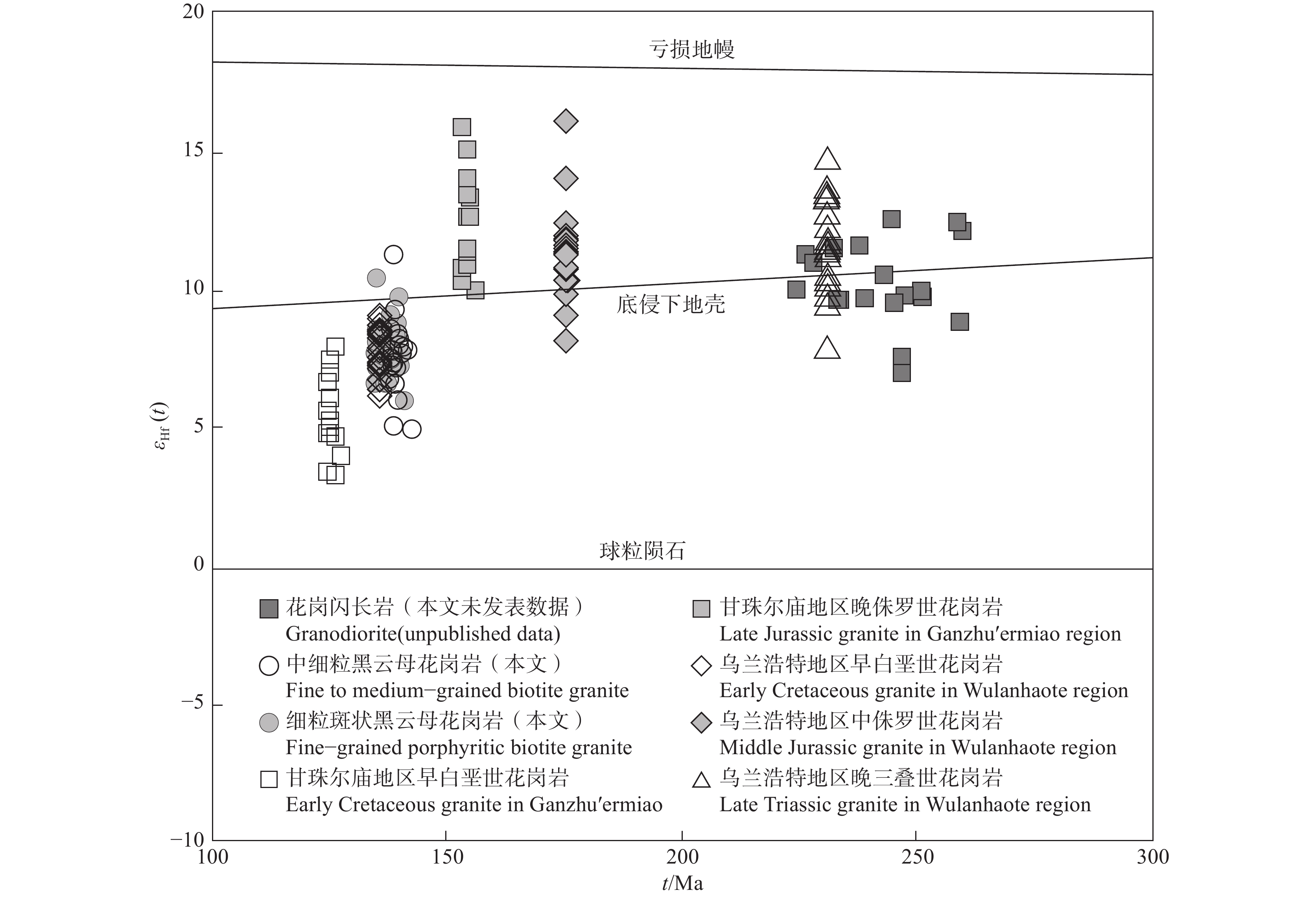Geochronology and geochemistry of Haliheiba pluton in the central and southern Great Hinggan Range and its tectonic delamination
-
摘要:研究目的
在区域地质调查基础上,本文探讨了大兴安岭中南段哈力黑坝岩体早白垩世花岗岩成岩年代、岩石成因类型、源区性质及地球动力学背景。
研究方法本文基于显微镜、XRF和(LA–)ICP–MS等手段对哈力黑坝岩体早白垩世花岗岩进行了岩相学、锆石U–Pb年代学、地球化学及Hf同位素组成研究。
研究结果哈力黑坝早白垩世花岗岩主要包括中细粒黑云母花岗岩和细粒斑状黑云母花岗岩,LA–ICP–MS锆石U–Pb定年结果分别为(139.1±0.7)Ma和(138.4±1.0)Ma。岩石主量元素具有高硅(74.09%~77.19%)、富碱(7.92%~8.46%),低CaO(0.35%~1.14%)和低MgO(0.15%~0.47%)的特征,属高钾钙碱性系列;其A/CNK值介于0.95~1.08,为准铝质—弱过铝质岩石。岩石相对富集轻稀土元素,(La/Yb)N=3.69~13.17,稀土配分模式图呈右倾海鸥型,具有较为明显的负铕异常(δEu = 0.11~0.47)。岩石微量元素组成显示岩石富集Rb、U、Th、Zr、Hf等元素,强烈亏损Sr、Ba、Ti、P等元素。岩石具有高正的εHf(t)值(+5.0~+11.2)和年轻的二阶段Hf模式年龄(408~731 Ma)。
结论哈力黑坝岩体早白垩世花岗岩为铝质A型花岗岩,其源区主要为年轻地壳物质,并有老地壳物质的贡献,形成于伸展的大地构造背景,受控于岩石圈拆沉减薄过程。
创新点:(1)哈力黑坝花岗岩为早白垩世铝质A型花岗岩,主要来源于年轻地壳物质的部分熔融;(2)哈力黑坝花岗岩形成于伸展构造背景,受到岩石圈拆沉减薄过程的控制。
Abstract:This paper is the result of geological survey engineering.
ObjectiveThe diagenetic age, petrogenetic types, source properties and geodynamic background of the Early Cretaceous granites of Haliheba pluton in the central and southern part of Great Hinggan Range are discussed based on the regional geological survey.
MethodsThe lithography of granite, U–Pb chronology, geochemistry and Hf isotope composition of zircon are studied by means of microscope, XRF and (LA–) ICP–MS.
ResultsThe Early Cretaceous granites in Haliheiba are composed of fine to medium–grained biotite granite and fine–grained porphyritic biotite granite, and zircon U–Pb ages are (139.1±0.7) Ma and (138.4±1.0) Ma, respectively. The granites are characterized by high SiO2 (74.09%−77.19%) and alkali enrichment (7.92%−8.46%), and belong to high–K calc–alkaline series. The A/CNK values range from 0.95 to 1.08, indicating that they are metaluminous to weakly peraluminous rocks. The chrondrite–normalized REE patterns are characterized by enrichment of LREEs with (La/Yb)N values varying from 3.69 to 13.17 and by prominent negative Eu anomalies with δEu values ranging from 0.11 to 0.47. The granites show the enrichment of Rb, U, Th , Nb, Ta, Zr and Hf, and the depletion of Sr, Ba, Ti and P. Zircon Hf isotopic compositions suggest that these granites have high positive εHf(t) values (+5.0 − +11.2) and fairly young two–stage Hf model ages (408−731 Ma).
ConclusionsThe Haliheiba granites are aluminous A–type granites, which were mainly derived from partial melting of the juvenile crustal materials associated with ancient crustal materials under extensional tectonic setting that was probably controlled by lithospheric delamination and thinning.
Highlights:(1) The Haliheba granites belong to Early Cretaceous aluminium A–type granites, which are mainly derived from partial melting of juvenile crustal materials; (2) The Haliheba granite was formed in extensional tectonic setting that was controlled by lithospheric delamination and thinning.
-
1. 研究目的(Objective)
湘中坳陷作为南方复杂构造区页岩气勘探的热点地区之一,也是中国油气勘探久攻未克的地区。前期在湘中地区北部的涟源凹陷泥盆系和石炭系获得了页岩气突破和发现,证实了湘中地区上古生界页岩气资源丰富。但对湘中地区南部的邵阳凹陷调查程度较为薄弱,针对邵阳凹陷二叠系仅开展了少量基础地质调查工作,页岩气资源潜力评价方面的工作尤为欠缺。本次研究依托邵阳湘邵地1井(XSD1井)钻探工程建立了邵阳凹陷二叠系地层层序序列,揭示了主要含气页岩层系的分布特征,获取了含气性评价参数,对湘中地区二叠系页岩气勘探开发和重新评价湘中坳陷页岩气资源潜力具有重要的现实意义。
2. 研究方法(Methods)
中国地质调查局武汉地质调查中心在收集分析区域地质相关资料的基础上,结合邵阳凹陷短陂桥向斜的煤田浅钻、非震物探等资料开展页岩气地质综合评价,采用页岩埋深500~4500 m,页岩有机碳含量≥1.0%,页岩厚度≥15 m,页岩有机质热演化程度1.0%~3.5%的评价参数在短陂桥向斜区优选页岩气远景区,论证部署了1口小口径页岩气地质调查井—XSD1井,湖南煤田地质勘查有限公司组织实施钻探(图 1a)。该井采样全井段取心钻井工艺,测井选取PSJ-2数字测井系统,录井采用SK-2000G气测录井,钻获二叠系大隆组156.05 m(暗色硅质页岩、钙质泥岩94.48 m),龙潭组349.95 m(暗色泥岩216.93 m,粉砂质泥岩36.9 m),对这两套层系共采集暗色泥岩样品33件,进行解析气含量测定分析,落实了含气性评价参数。
3. 结果(Results)
本次样品分析工作由武汉地质调查中心古生物与生命-环境协同演化重点实验室完成,采用YSQ-IIIA岩石解析气测定仪(燃烧法)对含气段岩心共计33件样品进行分析。该井钻获二叠系大隆组厚度156.05 m,为一套硅质岩、硅质页岩、炭质钙质泥岩地层。其中在井深842~930.2 m硅质页岩、钙质泥岩段,气测全烃值从1.06%上升至16.54%,甲烷值从1.01%上升至14.04%,13件大隆组硅质页岩现场解析总含气量为1.29~9.97 m3/t,平均4.85 m3/t。实现了湘中坳陷二叠系页岩气新发现,有效拓展了华南地区大隆组勘探范围。
钻获龙潭组厚度349.95 m,上段为一套细砂岩、粉砂岩夹泥岩潮坪相沉积地层,下段为一套炭质泥岩、粉砂质泥岩夹薄层细砂岩泻湖相沉积地层。在井深1013.4~1048 m泥岩与粉砂岩互层段气测全烃值最高可达19.87%,甲烷值最高为16.94%,7件泥岩与粉砂岩样品现场解析总含气量0.57~3.42 m3/t,平均1.78 m3/t;井深1088.10~1199.75 m泥岩夹泥质粉砂岩含气层111.6 m,气测全烃值最高可达28.2%,甲烷值最高为23.6%,13件泥岩、粉砂质泥岩样品现场解析总含气量0.90~4.55 m3/t,平均2.01 m3/t(图 1b),首次查明了湘中坳陷二叠系龙潭组非常规油气分布特点。
通过区域地质背景分析,并结合煤田区域地质资料,本研究认为滑脱断裂(F9)上下盘具有不同的页岩气聚集条件。滑脱断裂之上由一系列的同向逆断层形成的逆冲推覆体,地层变形强烈,且裂缝发育,导致页岩气保存条件变差。滑脱断裂下盘是页岩气主要富集区,地层平缓,不发育次级通天断裂,与下盘地层形成反向遮挡,易形成封闭,保存条件良好(图 1c)。
4. 结论(Conclusions)
(1)二叠系大隆组岩性以硅质岩、硅质页岩为主,夹少量灰岩。主要含气段存在于上段硅质页岩段,厚88.2 m,含气量平均为4.85 m3/t,含气性优越,资源潜力大。
(2)二叠系龙潭组上段以致密砂岩气为主,含气量平均为1.78 m3/t;下段以页岩气为主,泥岩厚达177.47 m,含气量平均为2.01 m3/t,具有泥岩厚度大,含气性好等特征。
(3)保存条件是页岩气富集关键,构造改造弱的封闭演化环境有利于页岩气保存,研究区滑脱断裂下盘是页岩气主要富集区,易形成封闭,保存条件良好。
(4)湘邵地1井在二叠系大隆组和龙潭组获得良好的页岩气显示,证实了湘中地区二叠系具有良好的页岩气资源潜力,对湘中地区页岩气资源潜力评价具有重要意义。
5. 基金项目(Fund support)
本文为中国地质调查局项目“中扬子地区油气页岩气调查评价”(DD20221659)资助的成果。
-
图 1 中亚造山带东部大地构造简图(a,底图据Zhou and Wilde, 2013修改)、大兴安岭中南段花岗岩分布图(b)和大兴安岭中南段花岗岩锆石U–Pb年龄分布直方图(c)
花岗岩年龄资料来源于Liu et al., 2005; 葛文春等, 2005; 刘伟等, 2007; 马星华等, 2009; 江思宏等, 2012; 王兴安等, 2012; Zhou et al., 2012; Li et al., 2013; 施璐等, 2013; 田德欣等, 2013; 杨奇荻等, 2014; 万乐, 2015; Zeng et al., 2015; 李剑锋等, 2016; 祝新友等, 2016
Figure 1. Tectonic sketch map of eastern Central Asian Orogenic Belt (a, modified from Zhou and Wilde, 2013), distribution map of granites from the central and southern Great Hinggan Range (b) and histogram of zircon U–Pb ages of granites from central and southern Great Hinggan Range (c)
Granites age data from Liu et al., 2005; Ge Wenchun et al., 2005; Liu Wei et al., 2007; Ma Xinghua et al., 2009; Jiang Sihong et al., 2012; Wang Xing’an et al., 2012; Zhou et al., 2012; Li et al., 2013; Shi Lu et al., 2013; Tian Dexin et al., 2013; Yang Qidi et al., 2014; Wan Le, 2015; Zeng et al., 2015; Li Jianfeng et al., 2016; Zhu Xinyou et al., 2016
图 3 哈力黑坝早白垩世花岗岩野外照片(a,c)及显微照片(b,d)
a, b—中细粒黑云母花岗岩;c, d—细粒斑状黑云母花岗岩;Qtz—石英;Kfs—钾长石;Pl—斜长石;Bt—黑云母;Ms—白云母;Ser—绢云母
Figure 3. Field photographs (a, c) and microphotographs (b, d) of Early Cretaceous granites in Haliheiba
a, b–Medium–fine grained biotite granite; c, d–Fine grained porphyritic biotite granite; Qtz–Quartz; Kfs–K−feldspar; Pl–Plagioclase; Bt–Biotite; Ms–Muscovite; Ser–Sericite
图 4 哈力黑坝早白垩世花岗岩代表性锆石CL图像(a)与锆石U–Pb年龄谐和图(b, c)
图a中黄色圈表示年龄测点,年龄单位Ma,红色圈表示Hf同位素测点
Figure 4. Representative cathodoluminescence (CL) images (a) and U–Pb concordia diagrams of zircons of Early Cretaceous granites in Haliheiba (b, c)
The yellow circles for U–Pb age analytical spots and red circles for Hf isotope analytical spots, age unit: Ma
图 6 哈力黑坝早白垩世花岗岩(a)球粒陨石标准化稀土配分图与(b)原始地幔标准化微量元素蛛网图(球粒陨石与原始地幔标准化值据Sun and McDonough, 1989)
Figure 6. Chondrite–normalized REE patterns (a) and primitive mantle–normalized trace element spider diagram (b) of Early Cretaceous granites in Haliheiba (chondrite–normalized and primitive mantle–normalized values after Sun and McDonough, 1989)
图 7 哈力黑坝早白垩世花岗岩成因判别图解
a~d—10000Ga/Al–Zr, Y, Ce, Nb图解(底图据Eby, 1992);e—SiO2–TFeO/(TFeO+MgO)图解(底图据Frost et al., 2001);f—SiO2–(Na2O+K2O–CaO)图解(底图据Frost et al., 2001)
Figure 7. Petrogenetic discrimination diagrams of Early Cretaceous granites in Haliheiba
a−d–10000Ga/Al vs. Zr, Y, Ce and Nb diagrams (after Eby, 1992); e–SiO2 vs. TFeO/(TFeO+MgO) diagrams (after Frost et al., 2001); f–SiO2 vs. (Na2O+K2O–CaO) diagrams (after Frost et al., 2001)
图 8 哈力黑坝早白垩世花岗岩εHf(t)–t图(底侵下地壳演化线据Liu et al., 2005;乌兰浩特地区花岗岩数据引自周漪等, 2011;甘珠尔庙地区花岗岩数据引自杨奇荻等, 2014)
Figure 8. εHf(t)–t diagram of Early Cretaceous granites in Haliheiba (The evolution lines of the underplated lower crust after Liu et al., 2005; εHf(t) values of the granites from Wulanhaote and Ganzhu'ermiao region after Zhou Yi et al. 2011 and Yang Qidi et al. 2014, respectively)
表 1 哈力黑坝早白垩世花岗岩锆石LA–ICP–MS分析结果
Table 1 LA–ICP–MS zircon U–Pb data of Early Cretaceous granites in Haliheiba
样品号及分析点号 含量/10−6 Th/U 同位素比值 年龄/Ma Th U 207Pb/206Pb 1σ 207Pb/235U 1σ 206Pb/238U 1σ 207Pb/206Pb 1σ 207Pb/235U 1σ 206Pb/238U 1σ CXPC3−1 148 360 0.41 0.04912 0.00196 0.1459 0.0052 0.02153 0.00025 153.7 91.0 138.3 4.6 137.3 1.6 CXPC3−2 321 933 0.34 0.05080 0.00134 0.1509 0.0029 0.02153 0.00022 231.7 59.6 142.7 2.6 137.3 1.4 CXPC3−3 455 1323 0.34 0.04888 0.00187 0.1461 0.0049 0.02167 0.00026 141.9 87.4 138.4 4.3 138.2 1.6 CXPC3−4 349 1227 0.28 0.04948 0.00126 0.1489 0.0027 0.02181 0.00022 170.5 58.6 140.9 2.4 139.1 1.4 CXPC3−5 253 837 0.30 0.05034 0.00143 0.1497 0.0033 0.02155 0.00022 210.9 64.6 141.6 2.9 137.5 1.4 CXPC3−6 173 578 0.30 0.04942 0.00155 0.1509 0.0038 0.02214 0.00024 167.9 71.5 142.7 3.4 141.1 1.5 CXPC3−7 44 151 0.29 0.04788 0.00298 0.1437 0.0085 0.02175 0.00031 92.3 142.1 136.3 7.5 138.7 2.0 CXPC3−8 129 314 0.41 0.05144 0.00208 0.1531 0.0055 0.02158 0.00026 260.6 90.3 144.7 4.8 137.6 1.6 CXPC3−9 81 260 0.31 0.04574 0.00220 0.1402 0.0062 0.02221 0.00028 0.1 95.4 133.2 5.5 141.6 1.8 CXPC3−10 375 327 1.15 0.06335 0.00239 0.1886 0.0062 0.02157 0.00026 719.9 78.2 175.4 5.3 137.6 1.6 CXPC3−11 367 617 0.59 0.06584 0.00261 0.1952 0.0067 0.02148 0.00027 801.2 80.8 181.0 5.7 137.0 1.7 CXPC3−12 284 1033 0.27 0.04884 0.00140 0.1452 0.0032 0.02154 0.00022 140.0 65.9 137.6 2.8 137.4 1.4 CXPC3−13 703 2048 0.34 0.05161 0.00123 0.1539 0.0024 0.02162 0.00021 268.0 53.8 145.4 2.1 137.9 1.3 CXPC3−14 298 954 0.31 0.05298 0.00147 0.1586 0.0033 0.02169 0.00022 327.7 61.6 149.4 2.9 138.3 1.4 CXPC3−15 170 440 0.39 0.04935 0.00173 0.1485 0.0044 0.02180 0.00024 164.4 79.8 140.6 3.9 139.0 1.5 CXPC3−16 431 1333 0.32 0.05091 0.00128 0.1530 0.0027 0.02177 0.00022 236.7 57.1 144.5 2.4 138.9 1.4 CXPC3−17 566 1659 0.34 0.05012 0.00125 0.1512 0.0026 0.02186 0.00022 200.6 56.7 143.0 2.3 139.4 1.4 CXPC3−18 346 1094 0.32 0.04936 0.00132 0.1479 0.0029 0.02172 0.00022 164.9 61.5 140.1 2.6 138.5 1.4 CXPC3−19 2272 2168 1.05 0.05492 0.00138 0.1638 0.0028 0.02161 0.00021 408.9 54.4 154.0 2.5 137.8 1.4 CXPC3−20 213 889 0.24 0.04994 0.00145 0.1513 0.0034 0.02195 0.00023 192.4 66.3 143.1 3.0 140.0 1.4 CXPC3−21 476 1024 0.46 0.05316 0.00147 0.1593 0.0033 0.02171 0.00022 335.8 61.4 150.1 2.9 138.4 1.4 CXPC3−22 497 1204 0.41 0.05136 0.00138 0.1547 0.0030 0.02183 0.00022 257.0 60.4 146.1 2.6 139.2 1.4 CXPC3−23 258 820 0.31 0.04987 0.00145 0.1532 0.0034 0.02225 0.00023 189.0 66.2 144.7 3.0 141.9 1.5 CXPC3−24 417 1181 0.35 0.05584 0.00147 0.1708 0.0032 0.02216 0.00022 445.8 57.2 160.1 2.8 141.3 1.4 CXPC7−1 359 1193 0.30 0.04922 0.00139 0.1447 0.0031 0.02130 0.00020 158.4 64.9 137.3 2.7 135.9 1.3 CXPC7−2 462 1342 0.34 0.05060 0.00134 0.1489 0.0028 0.02132 0.00019 222.4 60.3 140.9 2.5 136.0 1.2 CXPC7−3 443 1517 0.29 0.04993 0.00129 0.1487 0.0026 0.02159 0.00019 191.6 59.0 140.8 2.3 137.7 1.2 CXPC7−4 421 1398 0.30 0.05017 0.00139 0.1467 0.0030 0.02119 0.00019 202.7 63.0 139.0 2.6 135.2 1.2 CXPC7−5 464 1157 0.40 0.05076 0.00143 0.1489 0.0031 0.02127 0.00019 229.8 63.9 140.9 2.8 135.7 1.2 CXPC7−6 496 1239 0.40 0.04977 0.00131 0.1492 0.0027 0.02175 0.00019 184.4 60.2 141.2 2.4 138.7 1.2 CXPC7−7 578 1714 0.34 0.05240 0.00128 0.1541 0.0024 0.02132 0.00018 302.9 54.6 145.5 2.1 136.0 1.1 CXPC7−8 298 1018 0.29 0.04961 0.00139 0.1495 0.0031 0.02187 0.00019 176.6 64.1 141.5 2.7 139.4 1.2 CXPC7−9 345 598 0.58 0.04935 0.00159 0.1479 0.0038 0.02175 0.00020 164.5 73.8 140.1 3.4 138.7 1.3 CXPC7−10 285 1218 0.23 0.04845 0.00136 0.1417 0.0029 0.02122 0.00018 121.5 64.7 134.6 2.6 135.4 1.2 CXPC7−11 501 1442 0.35 0.05029 0.00130 0.1509 0.0027 0.02177 0.00018 208.2 58.9 142.7 2.4 138.9 1.1 CXPC7−12 205 563 0.36 0.04914 0.00172 0.1457 0.0042 0.02151 0.00021 154.7 79.9 138.1 3.8 137.2 1.3 CXPC7−13 198 476 0.42 0.04764 0.00188 0.1418 0.0048 0.02159 0.00022 80.8 91.8 134.6 4.3 137.7 1.4 CXPC7−14 437 1213 0.36 0.05039 0.00145 0.1524 0.0033 0.02194 0.00019 212.9 65.2 144.0 2.9 139.9 1.2 CXPC7−15 377 997 0.38 0.04984 0.00148 0.1522 0.0035 0.02215 0.00019 187.3 67.8 143.8 3.1 141.2 1.2 CXPC7−16 237 692 0.34 0.04960 0.00168 0.1483 0.0041 0.02168 0.00020 176.4 77.3 140.4 3.7 138.3 1.3 CXPC7−17 268 737 0.36 0.05013 0.00169 0.1527 0.0042 0.02209 0.00020 200.9 76.5 144.3 3.7 140.8 1.3 CXPC7−18 85 253 0.34 0.04607 0.00260 0.1405 0.0074 0.02210 0.00027 0.1 131.8 133.5 6.6 140.9 1.7 CXPC7−19 797 1897 0.42 0.05000 0.00128 0.1536 0.0027 0.02225 0.00017 195.0 58.4 145.1 2.3 141.9 1.1 CXPC7−20 554 1775 0.31 0.04979 0.00131 0.1508 0.0028 0.02194 0.00017 185.1 60.0 142.7 2.4 139.9 1.1 CXPC7−21 475 1521 0.31 0.04896 0.00135 0.1492 0.0030 0.02206 0.00017 146.1 63.5 141.2 2.6 140.7 1.1 表 2 哈力黑坝早白垩世花岗岩主微量元素含量(氧化物/%,微量元素/10−6)
Table 2 Major and trace element content of Early Cretaceous granites in Haliheiba (oxide/%, trace element/10−6)
样品号 CXPC3-1 CXPC3-2 CXPC3-3 CXPC7-1 CXPC7-2 CXPC7-3 CXPC7-4 岩性 中细粒黑云母花岗岩 细粒斑状黑云母花岗岩 SiO2 74.09 77.19 76.92 76.40 76.40 75.39 74.29 TiO2 0.20 0.15 0.08 0.13 0.16 0.13 0.20 Al2O3 12.60 12.19 12.09 12.45 12.09 12.67 12.79 Fe2O3 0.36 0.17 0.51 0.33 0.47 0.33 0.62 FeO 1.39 0.72 0.61 1.03 0.68 1.03 1.15 MnO 0.03 0.01 0.02 0.03 0.02 0.02 0.04 MgO 0.43 0.16 0.37 0.33 0.22 0.15 0.47 CaO 1.14 0.35 0.46 0.56 0.69 0.76 0.96 Na2O 3.73 3.14 3.41 3.86 3.62 3.83 3.79 K2O 4.73 5.12 4.68 4.09 4.30 4.53 4.43 P2O5 0.08 0.03 0.03 0.04 0.04 0.04 0.06 LOI 0.52 0.63 0.72 0.62 0.67 0.45 0.53 Total 99.45 99.93 99.96 99.96 99.43 99.44 99.45 Na2O+K2O 8.46 8.26 8.09 7.95 7.92 8.36 8.22 A/CNK 0.95 1.08 1.05 1.06 1.02 1.01 1.00 A/NK 1.12 1.14 1.13 1.16 1.14 1.13 1.16 σ 2.30 2.00 1.93 1.89 1.88 2.16 2.16 DI 91.32 95.48 94.66 93.42 94.10 93.47 91.24 Li 20.70 13.60 14.30 19.00 15.00 20.90 19.00 Be 3.59 5.33 7.62 4.88 5.09 5.30 4.23 Sc 1.85 2.67 1.18 1.48 1.48 1.47 2.15 V 10.90 5.08 2.81 5.47 5.87 4.67 8.12 Cr 1.63 0.99 0.81 1.21 1.13 0.73 1.72 Co 1.79 0.78 0.78 1.02 1.08 0.82 1.56 Ni 1.60 1.12 0.99 1.17 0.99 0.88 1.33 Cu 4.18 45.00 2.11 2.53 3.17 6.50 6.90 Zn 57.40 38.10 31.20 39.30 34.10 41.60 39.40 Ga 22.20 24.70 24.20 20.10 19.50 20.30 19.00 Rb 191.00 241.00 216.00 166.00 160.00 192.00 174.00 Sr 160.00 41.30 31.90 72.70 91.10 72.00 83.40 Mo 0.67 2.80 0.86 0.62 0.42 0.90 0.51 Cd 0.23 0.20 0.13 0.18 0.20 0.18 0.16 In 0.03 0.03 0.03 0.03 0.02 0.02 0.04 Sb 0.08 0.12 0.14 0.11 0.19 0.06 0.10 Cs 3.83 4.60 6.47 4.04 2.79 4.24 6.43 Ba 370.00 119.00 77.30 153.00 270.00 153.00 283.00 W 2.72 70.90 1.01 0.92 0.87 0.90 1.13 Tl 1.09 1.69 1.21 0.83 1.15 1.12 0.99 Pb 22.70 20.20 24.00 23.00 19.30 37.40 18.00 Bi 1.75 0.37 1.81 0.19 3.11 4.01 0.47 Th 42.20 22.10 55.00 34.10 22.90 36.80 33.10 U 4.89 2.30 6.12 5.37 2.79 12.10 3.15 Nb 11.20 11.10 22.50 11.10 12.00 21.10 11.70 Ta 1.89 1.24 5.93 1.63 1.72 2.95 1.28 Zr 124.00 113.00 111.00 106.00 80.70 109.00 129.00 Hf 4.34 4.93 5.31 3.89 3.18 4.51 4.53 La 36.10 36.70 31.70 26.10 38.00 35.60 35.30 Ce 64.50 81.70 68.00 59.30 72.00 75.30 64.90 Pr 7.29 11.10 7.11 5.48 7.28 9.15 7.17 Nd 25.00 39.80 25.70 19.40 25.10 30.20 28.00 Sm 3.82 6.30 5.01 3.34 3.72 6.06 4.68 Eu 0.55 0.26 0.18 0.28 0.38 0.26 0.40 Gd 3.35 5.92 4.79 3.18 3.33 5.31 4.11 Tb 0.59 0.99 1.11 0.61 0.53 1.05 0.73 Dy 2.88 5.31 6.71 3.57 2.80 5.64 3.64 Ho 0.55 1.07 1.47 0.73 0.53 1.15 0.79 Er 1.74 3.06 4.37 2.33 1.54 3.54 2.29 Tm 0.35 0.53 0.88 0.47 0.28 0.70 0.42 Yb 2.30 3.80 6.17 3.00 2.07 5.20 2.84 Lu 0.33 0.47 0.89 0.45 0.29 0.71 0.44 Y 18.50 28.60 45.80 21.50 15.50 37.70 24.30 ∑REE 167.83 225.62 209.89 149.74 173.35 217.56 180.01 LREE/HREE 4.39 3.51 1.90 3.15 5.36 2.55 3.50 δEu 0.47 0.13 0.11 0.26 0.33 0.14 0.28 (La/Yb)N 11.26 6.93 3.69 6.24 13.17 4.91 8.92 10000Ga/Al 3.33 3.83 3.78 3.05 3.05 3.03 2.80 Zr+Nb+Ce+Y 218.20 234.40 247.30 197.90 180.20 243.10 229.90 表 3 哈力黑坝早白垩世花岗岩锆石Hf同位素分析结果
Table 3 Zircon Hf isotopic composition of Early Cretaceous granites in Haliheiba
点号 t/Ma 176Hf/177Hf 176Yb/177Hf 176Lu/177Hf 2σ εHf(t) 2σ TDM1/Ma TDM2/Ma fLu/Hf CXPC3−1 137.3 0.282903 0.025060 0.000699 0.000003 7.6 0.1 490 594 −0.98 CXPC3−2 137.3 0.282934 0.034261 0.000960 0.000009 8.6 0.3 451 540 −0.97 CXPC3−3 138.2 0.282950 0.038447 0.001053 0.000005 9.2 0.2 429 511 −0.97 CXPC3−4 139.1 0.282922 0.032150 0.000904 0.000002 8.3 0.1 467 561 −0.97 CXPC3−5 137.5 0.282896 0.032285 0.000897 0.000010 7.3 0.3 504 609 −0.97 CXPC3−6 141.1 0.282909 0.028014 0.000791 0.000001 7.9 0.0 484 583 −0.98 CXPC3−7 138.7 0.282927 0.022330 0.000631 0.000004 8.5 0.2 456 551 −0.98 CXPC3−8 137.6 0.282832 0.041640 0.001162 0.000003 5.0 0.1 597 725 −0.96 CXPC3−9 141.6 0.282827 0.022111 0.000604 0.000001 5.0 0.0 596 731 −0.98 CXPC3−10 137.6 0.282900 0.042228 0.001143 0.000012 7.4 0.4 501 602 −0.97 CXPC3−11 137.0 0.282880 0.033415 0.000911 0.000002 6.8 0.1 526 637 −0.97 CXPC3−12 137.4 0.282933 0.033815 0.000922 0.000004 8.6 0.2 451 541 −0.97 CXPC3−13 137.9 0.282913 0.058903 0.001581 0.000019 7.9 0.7 488 580 −0.95 CXPC3−14 138.3 0.282875 0.034884 0.000979 0.000007 6.6 0.2 534 647 −0.97 CXPC3−15 139.0 0.282917 0.028177 0.000738 0.000002 8.1 0.1 472 569 −0.98 CXPC3−16 138.9 0.282858 0.034047 0.000949 0.000003 6.0 0.1 558 677 −0.97 CXPC3−17 139.4 0.282909 0.053215 0.001389 0.000003 7.8 0.1 491 586 −0.96 CXPC3−18 138.5 0.282892 0.033775 0.000914 0.000002 7.2 0.1 509 616 −0.97 CXPC3−19 137.8 0.283008 0.071354 0.001896 0.000002 11.2 0.1 354 408 −0.94 CXPC3−20 140.0 0.282912 0.029114 0.000813 0.000005 7.9 0.2 480 578 −0.98 CXPC7−1 135.9 0.282936 0.031750 0.000888 0.000002 8.7 0.1 447 536 −0.97 CXPC7−2 136.0 0.282923 0.037649 0.001083 0.000012 8.2 0.4 467 560 −0.97 CXPC7−3 137.7 0.282877 0.037908 0.001043 0.000005 6.6 0.2 532 644 −0.97 CXPC7−4 135.2 0.282880 0.044944 0.001376 0.000011 6.7 0.4 532 640 −0.96 CXPC7−5 135.7 0.282896 0.054362 0.001436 0.000023 7.2 0.8 511 611 −0.96 CXPC7−6 138.7 0.282924 0.034846 0.000970 0.000004 8.3 0.1 464 557 −0.97 CXPC7−7 136.0 0.282988 0.043114 0.001156 0.000011 10.5 0.4 375 441 −0.97 CXPC7−8 139.4 0.282909 0.026305 0.000728 0.000005 7.8 0.2 483 583 −0.98 CXPC7−9 138.7 0.282903 0.036297 0.001021 0.000003 7.6 0.1 496 597 −0.97 CXPC7−10 135.4 0.282912 0.035219 0.000960 0.000003 7.8 0.1 482 581 −0.97 CXPC7−11 138.9 0.282946 0.038714 0.001070 0.000005 9.1 0.2 434 518 −0.97 CXPC7−12 137.2 0.282910 0.084491 0.002193 0.000032 7.7 1.1 501 589 −0.93 CXPC7−13 137.7 0.282925 0.050315 0.001390 0.000007 8.3 0.2 468 558 −0.96 CXPC7−14 139.9 0.282927 0.051037 0.001377 0.000017 8.4 0.6 465 553 −0.96 CXPC7−15 141.2 0.282905 0.027553 0.000782 0.000002 7.7 0.1 489 591 −0.98 CXPC7−16 138.3 0.282877 0.039219 0.001092 0.000006 6.7 0.2 533 644 −0.97 CXPC7−17 140.8 0.282909 0.040882 0.001138 0.000015 7.8 0.5 488 585 −0.97 CXPC7−18 140.9 0.282894 0.029011 0.000810 0.000001 7.3 0.0 505 611 −0.98 CXPC7−19 141.9 0.282858 0.043941 0.001221 0.000005 6.0 0.2 562 678 −0.96 CXPC7−20 139.9 0.282939 0.045649 0.001231 0.000009 8.9 0.3 446 531 −0.96 CXPC7−21 140.7 0.282966 0.036242 0.000951 0.000003 9.9 0.1 405 480 −0.97 -
[1] Andersen T. 2002. Correction of common lead in U−Pb analyses that do not report 204Pb[J]. Chemical Geology, 192: 59−79. doi: 10.1016/S0009-2541(02)00195-X
[2] Collins W J, Beams S D, White A J R, Chappell B W. 1982. Nature and origin of A−type granites with particular reference to southeastern Australia[J]. Contributions to Mineralogy and Petrology, 80: 189−200. doi: 10.1007/BF00374895
[3] Du Yang, Liu Zhenghong, Cui Weilong, Wang Shijie, Wang Yang, Du Chuanye. 2017. Formation age and geochemical characteristics of volcanic rocks from Manketouebo Formation in Keyihe area, Da Higgan Mountains and its tectonic implications[J]. Global Geology, 36(1): 54−65 (in Chinese with English abstract).
[4] Eby G N. 1992. Chemical subdivision of the A−type granitoids: Petrogenetic and tectonic implications[J]. Geology, 20: 641−644.
[5] Frost B R, Barnes C G, Collins W J, Arculus R J, Ellis D J, Frost C D. 2001. A geochemical classification for granitic rocks[J]. Journal of Petrology, 42(11): 2033−2048. doi: 10.1093/petrology/42.11.2033
[6] Gao Xiaofeng, Guo Feng, Fan Weiming, Li Chaowen, Li Xiaoyong. 2005. Origin of the Mesozoic intermediate−felsic volcanic rocks from the northern Da Hinggan Mountain, NE China[J]. Acta Petrologica Sinica, 21(3): 737−748 (in Chinese with English abstract).
[7] Ge Wenchun, Wu Fuyuan, Zhou Changyong, Zhang Jiheng. 2005. Zircon U−Pb ages and its significance of the Mesozoic granites in the Wulanhaote region, central Da Hinggan Mountain[J]. Acta Petrologica Sinica, 21(3): 749−762 (in Chinese with English abstract).
[8] He Peng, Guo Shuo, Zhang Tianfu, Zhang Yuelong, Su Hang, Fu Qilong. 2022. Geochronology, geochemistry and tectonic setting of volcanic rocks from Manketouebo Formation in Wulagai area, southern Da Hinggan Mountains[J]. Geology in China, 49(2): 601−619 (in Chinese with English abstract).
[9] Hong Dawei, Wang Shiguang, Xie Xilin, Zhang Jisheng. 2000. Genesis of positive εNd(t) granitoids in the Da Hinggan Mts. —Mongolia orogenic belt and growth continental crust[J]. Earth Science Frontiers, (2): 441−456 (in Chinese with English abstract).
[10] Jiang Sihong, Liang Qingling, Liu Yifei, LiuYan. 2012. Zircon U−Pb ages of the magmatic rocks occurring in around the Dajing Cu−Ag−Sn polymetallic deposit of Inner Mongolia and constrains to the ore−forming age[J]. Acta Petrologica Sinica, 28(2): 495−513 (in Chinese with English abstract).
[11] Jiang Sihong, Nie Fengjun, Bai Daming, Liu Yifei, Liu Yan. 2011a. Geochronology evidence for Indosinian mineralization in Baiyinnuoer Pb−Zn deposit of Inner Mongolia[J]. Mineral Deposits, 30(5): 787−798 (in Chinese with English abstract).
[12] Jiang Sihong, Nie Fengjun, Liu Yifei, Hou Wanrong, Bai Daming, Liu Yan, Liang Qingling. 2011b. Geochronology of intrusive rocks occurring in and around the Mengentaolegai silver−polymetallic deposit, Inner Mongolia[J]. Journal of Jilin University (Earth Science Edition), 41(6): 1755−1769 (in Chinese with English abstract).
[13] Li Jianfeng, Wang Keyong, Quan Hongyan, Sun Fengyue, Zhao Laishi, Zhang Xuebing. 2016. Discussion on the magmatic evolution sequence and metallogenic geodynamical setting background Hongling Pb−Zn deposit in the southern Da Xing'an Mountains[J]. Acta Petrologica Sinica, 32(5): 1529−1542 (in Chinese with English abstract).
[14] Li Jinyi, Gao Liming, Sun Guihua, Li Yaping, Wang Yanbo. 2007. Shuangjingzi middle Triassic syn−collisional crust−derived granite in the east Inner Mongolia and its constraint on the timing of collision between Siberian and Sino−Korean Paleo−plates[J]. Acta Petrologica Sinica, (3): 565−582 (in Chinese with English abstract).
[15] Li S, Wilde S A, Wang T, Guo Q Q. 2013. Incremental growth and origin of the Cretaceous Renjiayingzi pluton, southern Inner Mongolia, China: Evidence from structure, geochemistry and geochronology[J]. Journal of Asian Earth Sciences, 75(8): 226−242.
[16] Liu Chen, Sun Jinggui, Qiu Dianming, Gu A'lei, Han Jilong, Sun Fanting, Yang Mei, Feng Yangyang. 2017. Genesis and geological significance of Mesozoic volcanic rocks in Xiaomo'erke, northern slope of Greater Khingan Range: Hf isotopic geochemistry and zircon U−Pb chronology[J]. Journal of Jilin University (Earth Science Edition), 47(4): 1138−1158 (in Chinese with English abstract).
[17] Liu W, Siebel W, Li X J, Pan X F. 2005. Petrogenesis of the Linxi granitoids, northern Inner Mongolia of China: Constraints on basaltic underplating[J]. Chemical Geology, 219(1/4): 5−35.
[18] Liu Wei, Pan Xiaofei, Xie Liewen, Li He. 2007. Sources of material for the Linxi granitoids, the southern segment of the Da Hinggan Mts. : When and how continental crust grew[J]. Acta Petrologica Sinica, 23(2): 441−460 (in Chinese with English abstract).
[19] Liu Y J, Li W M, Feng Z Q, Wen Q B, Neubauer F, Liang C Y. 2016. A review of the Paleozoic tectonics in the eastern part of Central Asian Orogenic Belt[J]. Gondwana Research, 43: 123−148.
[20] Loiselle M C, Wones D R. 1979. Characteristics and origin of anorogenic granites[J]. Geological Society of America, Abstracts with Programs, 11: 468.
[21] Ludwig K R. 2001. User’s Manual for Isoplot/EX (Rev. 2.49): A Geochronological Toolkit for Microsoft Excel[M]. Berkeley Geochronology Center Special Publication, 1−55.
[22] Ma Xinghua, Chen Bin, Lai Yong, Lu Yinghuai. 2009. Petrogenesis and mineralization chronology study on the Aolunhua porphyry Mo deposit, Inner Mongolia, and its geological implications[J]. Acta Petrologica Sinica, 25(11): 247−258 (in Chinese with English abstract).
[23] Mao Jingwen, Zhou Zhenhua, Wu Guang, Jiang Sihong, Liu Chenglin, Li Houmin, Ouyang Hegen, Liu Jun. 2013. Metallogenic regularity and metallogenic series of ore deposits in Inner Mongolia and adjacent areas[J]. Mineral Deposits, 32(4): 715−729 (in Chinese with English abstract).
[24] Mei Wei. 2014. Mesozoic Magmatism and Mineralization in Northern Chifeng, Inner Mongolia[D]. Wuhan: China University of Geosciences, 1−174.
[25] Pan Xiaofei, Guo Lijun, Wang Shuo, Xue Huaimin, Hou Zengqian, Tong Ying, Li Zhiming. 2009. Laser microprobe Ar−Ar dating of biotite from the Weilasituo Cu−Zn polymetallic deposit in Inner Mongolia[J]. Acta Petrologica et Mineralogica, 28(5): 473−479 (in Chinese with English abstract).
[26] Sengör A M C, Natal’in B A, Burtman V S. 1993. Evolution of the Altaid tectonic collage and Palaeozoic crustal growth in Eurasia[J]. Nature, 364: 299−307. doi: 10.1038/364299a0
[27] Shao Ji’an, Zhang Lüqiao. 2002. Mesozoic dyke swarms in the north of North China[J]. Acta Petrologica Sinica, (3): 312−318 (in Chinese with English abstract).
[28] Shao Ji’an, Zhang Lüqiao, Mu Baolei. 1999. Magmatism in the Mesozoic extending orogenic process of Da Hinggan Mts[J]. Earth Science Frontiers, (4): 339−346 (in Chinese with English abstract).
[29] Shao Ji’an, Zhang Lüqiao, Xiao Qinghui, Li Xiaobo. 2005. Rising of Da Hinggan Mts. in Mesozoic: A possible mechanism of intracontinental orogeny[J]. Acta Geologica Sinica, (3): 789−794 (in Chinese with English abstract).
[30] Shi Lu, Zheng Changqing, Yao Wengui, Li Juan, Xu Jiulei, Gao Yuan, Cui Fanghua. 2013. Geochronology, petro−geochemistry and tectonic setting of the Hamagou Forest Farm A−type granites in the Wuchagou region, central Great Xinggan Range[J]. Acta Geologica Sinica, 87(9): 1264−1276 (in Chinese with English abstract).
[31] Su Maorong, Li Yinglei, Liu Huichuan, Shao Yongxu, Zhang Qing, Zhou Fei, Cao Lei, Sun Jinghao. 2020. Paleoproterozoic basement in eastern Central Asia Orogenic Belt: Evidence from granite and sedimentary strata in Sino−Mongolia border area[J]. Geology in China, 47(4): 1186−1203 (in Chinese with English abstract).
[32] Sun S S, McDonough W F. 1989. Chemical and isotopic systematics of oceanic basalts: Implications for mantle compositions and processes[J]. Geological Society, London, Special Publications, 42(1): 313−345.
[33] Tian Dexin, Wang Qinghai, Ge Wenchun, Zhang Yanlong, Chen Huijun, Yang Hao. 2013. Zircon U−Pb ages and geochemical characteristics of Lüshui alkali feldspar granites in Arshan, Inner Mongolia and their tectonic implications[J]. Global Geology, 32(4): 681−693 (in Chinese with English abstract).
[34] Wan Duo, Li Jianfeng, Wang Yicun, Wang Keyong, Wang Zhigao, Wei Liangmin. 2014. Re−Os radiometric dating of molybdenite in Hongling lead−zinc polymetallic deposit, Inner Mongolia, and its significance[J]. Earth Science—Journal of China University of Geosciences, 39(6): 687−695 (in Chinese with English abstract). doi: 10.3799/dqkx.2014.064
[35] Wan Le. 2015. Tectonic Setting and Geological Characteristics of the Mesozoic Granites of Wushijiazi in Inner Mongolia[D]. Beijing: China University of Geosciences (Beijing), 1−69 (in Chinese with English abstract).
[36] Wang Xing’an, Xu Zhongyuan, Liu Zhenghong, Zhu Kai. 2012. Petrogenesis and tectonic setting of the K−feldspar granites in Chaihe area, central Greater Xing’an Range: Constraints from petro−geochemistry and zircon U−Pb isotope chronology[J]. Acta Petrologica Sinica, 28(8): 2647−2655 (in Chinese with English abstract).
[37] Wei W, Zou T, Huang X K, Jiang B B, Zhu X Y, Wu X Y. 2020. Petrogenesis of early Cretaceous granitoids in the southern Great Xing’an Range, NE China: Constraints from the Haliheiba pluton[J]. Chemie der Erde−Geochemistry, 80: 125608.
[38] Wei Wei, Chen Jianping, Huang Xingkai, Zhu Xinyou, Xu Qiao, Liu Zi. 2017. Magmatic migmatization of Haliheiba pluton: Petrographic study of dark inclusion, U–Pb chronology and Hf isotope of zircon mineral in central and southern section of the Da Hinggan Mountains area[J]. Mineral Exploration, 8(6): 948−956 (in Chinese with English abstract).
[39] Whalen J B, Currie K L, Chappell B W. 1987. A−type granites: Geochemical characteristics, discrimination and petrogenesis[J]. Contributions to Mineralogy and Petrology, 95(4): 407−419. doi: 10.1007/BF00402202
[40] Wilde S A, Zhou J B. 2015. The late Paleozoic to Mesozoic evolution of the eastern margin of the Central Asian orogenic belt in China[J]. Journal of Asian Earth Sciences, 113: 909−921. doi: 10.1016/j.jseaes.2015.05.005
[41] Wilde S A. 2015. Final amalgamation of the Central Asian Orogenic Belt in NE China: Paleo−Asian Ocean closure versus Paleo−Pacific plate subduction: A review of the evidence[J]. Tectonophysics, 662: 345−362. doi: 10.1016/j.tecto.2015.05.006
[42] Wu Fuyuan, Lin Qiang, Jahn Bor−ming. 1997. On the isotopic characteristics of the post−orogenic granites in orogenic belt of north China and their implications for crustal growth[J]. Chinese Science Bulletin, (20): 2188−2192 (in Chinese).
[43] Wu Fuyuan, Sun Deyou. 1999. The Mesozoic magmatism and lithospheric thinning in eastern China[J]. Journal of Changchun University of Science and Technology, (4): 313−318 (in Chinese with English abstract).
[44] Wu Fuyuan, Sun Deyou, Zhang Guangliang, Ren Xiangwen. 2000. Deep geodynamics of Yanshanian Movement[J]. Geological Journal of China Universities, (3): 379−388 (in Chinese with English abstract).
[45] Wu F Y, Han R, Yang J H, Wilde S A, Zhai M G. 2007. Initial constraints on the timing of granitic magmatism in North Korea using U−Pb zircon geochronology[J]. Chemical Geology, 238: 232−248. doi: 10.1016/j.chemgeo.2006.11.012
[46] Wu F Y, Jahn B M, Wilde S A, Sun D Y. 2000. Phanerozoic continental crustal growth: Sr–Nd isotopic evidence from the granites in northeastern China[J]. Tectonophysics, 328: 87−113.
[47] Wu F Y, Sun D Y, Li H M, Jahn B M, Wilde S A. 2002. A−type granites in northeastern China: Age and geochemical constrains on their petrogenesis[J]. Chemical Geology, 187: 143−173. doi: 10.1016/S0009-2541(02)00018-9
[48] Wu F Y, Sun D Y, Ge W C, Zhang Y B, Grant M L, Wilde S A, Jahn B M. 2011. Geochronology of the Phanerozoic granitoids in northeastern China[J]. Journal of Asian Earth Sciences, 41(1): 1−30. doi: 10.1016/j.jseaes.2010.11.014
[49] Wu F Y, Wilde S A, Zhang G L, Sun D Y. 2004. Geochronology petrogenesis of the post−orogenic Cu–Ni sulfide−bearing mafic–ultramafic complexes in Jilin Province, NE China[J]. Journal of Asian Earth Sciences, 23: 781−797. doi: 10.1016/S1367-9120(03)00114-7
[50] Wu Guanbin, Liu Jingmin, Zeng Qingdong, Sun Huashan, Liu Mingtao. 2013. Inner Mongolia Daxinganling double top mountain lead zinc silver mineralization age[J]. Journal of Minerals, 33(S2): 619 (in Chinese).
[51] Xiao W J, Windley B F, Hao J, Zhai M G. 2003. Accretion leading to collision and the Permian Solonker suture, Inner Mongolia, China: Termination of the Central Asian Orogenic Belt[J]. Tectonics, 22: 1069.
[52] Yang J H, Wu F Y, Wilde S A, Xie L W, Yang Y H, Liu X M. 2007. Tracing magma mixing in granite genesis: In situ U−Pb dating and Hf isotope analysis of zircons[J]. Contributions to Mineralogy and Petrology, 247: 100−118.
[53] Yang Qidi, Guo Lei, Wang Tao, Zeng Tao, Zhang Lei, Tong Ying, Shi Xingjun, Zhang Jianjun. 2014. Geochonology, origin, sources and tectonic settings of Late Mesozoic two–stage granites in the Ganzhuermiao region, central and southern Da Hinggan Range, NE China[J]. Acta Petrologica Sinica, 30(7): 1961−1981 (in Chinese with English abstract).
[54] Yuan H L, Gao S, Dai M N, Zong C L, Günther D, Fontaine G H, Liu X M, Diwu C R. 2008. Simultaneous determinations of U–Pb age, Hf isotopes and trace element compositions of zircon by excimer laser−ablation quadrupole and multiple−collector ICP−MS[J]. Chemical Geology, 247: 100−118. doi: 10.1016/j.chemgeo.2007.10.003
[55] Yuan H L, Gao S, Liu X M, Li H M, Günther D, Wu F Y. 2004. Accurate U−Pb age and trace element determinations of zircon by laser ablation−inductively coupled plasma mass spectrometry[J]. Geostandards Newsletter, 28: 353−370.
[56] Zeng Q D, Sun Y, Chu S X, Duan X X, Liu J M. 2015. Geochemistry and geochronology of the Dongshanwan porphyry Mo−W deposit, Northeast China: Implications for the Late Jurassic tectonic setting[J]. Journal of Asian Earth Sciences, 97: 472−485. doi: 10.1016/j.jseaes.2014.07.027
[57] Zhai Degao, Liu Jiajun, Yang Yongqiang, Wang Jianping, Ding Li, Liu Xingwang, Zhang Mei, Yao Meijuan, Su Li, Zhang Hongyu. 2012. Petrogenetic and metallogentic ages and tectonic setting of the Huanggangliang Fe–Sn deposit, Inner Mongolia[J]. Acta Petrologica et Mineralogica, 31(4): 513−523 (in Chinese with English abstract).
[58] Zhang Chao, Yang Weihong, He Zhonghua, Wu Hao, Wu Qing. 2014. Chronology and geochemistry of rhyolites in Manketou'ebo Formation from Ta'erqi area, southern–central Great Xing'an Range[J]. Global Geology, 33(2): 255−265 (in Chinese with English abstract).
[59] Zhang J H, Gao S, Ge W C, Wu F Y, Yang J H, Wilde S A, Li M. 2010. Geochronology of the Mesozoic volcanic rocks in the Great Xingan Range, northeastern China: Implications for subduction−induced delamination[J]. Chemical Geology, 276: 144−165. doi: 10.1016/j.chemgeo.2010.05.013
[60] Zhang L C, Zhou X H, Ying J F, Wang F, Guo F, Wan B, Chen Z G. 2008. Geochemistry and Sr−Nd−Pb−Hf isotopes of Early Cretaceous basalts from the Great Xinggan Range, NE China: Implications for their origin and mantle source characteristics[J]. Chemical Geology, 256: 12−23. doi: 10.1016/j.chemgeo.2008.07.004
[61] Zhang Lianchang, Chen Zhiguang, Zhou Xinhua, Ying Jifeng, Wang Fei, Zhang Yutao. 2007. Characteristics of deep sources and tectonic−magmatic evolution of the Early Cretaceous volcanics in Genhe area, Da−Hinggan Mountains: Constraints of Sr−Nd−Pb−Hf isotopic geochemistries[J]. Acta Petrologica Sinica, 23(11): 2823−2835 (in Chinese with English abstract).
[62] Zhang Qi, Jin Weijun, Li Chengdong, Wang Yan, Wang Yuanlong. 2011. Granitic rocks and their formation depth in the crust[J]. Geotectonica et Metallogenia, 35(2): 259−269 (in Chinese with English abstract).
[63] Zhou J B, Wilde S A. 2013. The crustal accretion history and tectonic evolution of the NE China segment of the Central Asian Orogenic Belt[J]. Gondwana Research, 23: 1365−1377. doi: 10.1016/j.gr.2012.05.012
[64] Zhou Yi, Ge Wenchun, Wang Qinghai. 2011. Petrogenesis of Mesozoic granite in Wulanhaote region, central Da Hinggan Mountains: Constraints from geochemistry and Sr−Nd−Hf isotope[J]. Acta Petrologica et Mineralogica, 30(5): 901−923 (in Chinese with English abstract).
[65] Zhou Z H, Mao J W, Lyckberg P. 2012. Geochronology and isotopic geochemistry of the A−type granites from the Huanggang Sn−Fe deposit, southern Great Hinggan Range, NE China: Implication for their origin and tectonic setting[J]. Journal of Asian Earth Science, 49: 272−286. doi: 10.1016/j.jseaes.2012.01.015
[66] Zhou Zhenhua, Lü Linsu, Feng Jiarui, Li Chao, Li Tao. 2010. Molybdenite Re−Os ages of Huanggang skarn Sn−Fe deposit and their geological significance, Inner Mongolia[J]. Acta Petrologica Sinica, 26(3): 667−679 (in Chinese with English abstract).
[67] Zhu Xinyou, Zhang Zhihui, Fu Xu, Li Baiyang, Wang Yanli, Jiao Shoutao, Sun Yalin. 2016. Geological and geochemical characteristics of the Weilasito Sn−Zn deposit, Inner Mongolia[J]. Geology in China, 43(1): 188−208 (in Chinese with English abstract).
[68] 杜洋, 刘正宏, 崔维龙, 王师捷, 王阳, 杜传业. 2017. 大兴安岭克一河地区满克头鄂博组火山岩形成时代、地球化学特征及地质意义[J]. 世界地质, 36(1): 54−65. doi: 10.3969/j.issn.1004-5589.2017.01.005 [69] 高晓峰, 郭锋, 范蔚茗, 李超文, 李晓勇. 2005. 南兴安岭晚中生代中酸性火山岩的岩石成因[J]. 岩石学报, 21(3): 737−748. doi: 10.3321/j.issn:1000-0569.2005.03.014 [70] 葛文春, 吴福元, 周长勇, 张吉衡. 2005. 大兴安岭中部乌兰浩特地区中生代花岗岩的锆石U−Pb年龄及地质意义[J]. 岩石学报, 21(3): 749−762. doi: 10.3321/j.issn:1000-0569.2005.03.015 [71] 何鹏, 郭硕, 张天福, 张跃龙, 苏航, 付启龙. 2022. 大兴安岭南部乌拉盖地区满克头鄂博组火山岩年代学、地球化学研究及构造环境分析[J]. 中国地质, 49(2): 601−619. [72] 洪大卫, 王式銧, 谢锡林, 张季生. 2000. 兴蒙造山带正εNd(t)值花岗岩的成因和大陆地壳生长[J]. 地学前缘, (2): 441−456. doi: 10.3321/j.issn:1005-2321.2000.02.012 [73] 江思宏, 梁清玲, 刘翼飞, 刘妍. 2012. 内蒙古大井矿区及外围岩浆岩锆石U−Pb年龄及其对成矿时间的约束[J]. 岩石学报, 28(2): 495−513. [74] 江思宏, 聂凤军, 白大明, 刘翼飞, 刘妍. 2011a. 内蒙古白音诺尔铅锌矿床印支期成矿的年代学证据[J]. 矿床地质, 30(5): 787−798. [75] 江思宏, 聂凤军, 刘翼飞, 侯万荣, 白大明, 刘妍, 梁清玲. 2011b. 内蒙古孟恩陶勒盖银多金属矿床及其附近侵入岩的年代学[J]. 吉林大学学报(地球科学版), 41(6): 1755−1769. [76] 李剑锋, 王可勇, 权鸿雁, 孙丰月, 赵来时, 张雪冰. 2016. 大兴安岭南段红岭铅锌矿床岩浆演化序列与成矿动力学背景探讨[J]. 岩石学报, 32(5): 1529−1542. [77] 李锦轶, 高立明, 孙桂华, 李亚萍, 王彦斌. 2007. 内蒙古东部双井子中三叠世同碰撞壳源花岗岩的确定及其对西伯利亚与中朝古板块碰撞时限的约束[J]. 岩石学报, (3): 565−582. doi: 10.3969/j.issn.1000-0569.2007.03.004 [78] 刘晨, 孙景贵, 邱殿明, 古阿雷, 韩吉龙, 孙凡婷, 杨梅, 冯洋洋. 2017. 大兴安岭北段东坡小莫尔可地区中生代火山岩成因及其地质意义: 元素、Hf同位素地球化学与锆石U−Pb同位素定年[J]. 吉林大学学报(地球科学版), 47(4): 1138−1158. [79] 刘伟, 潘小菲, 谢烈文, 李禾. 2007. 大兴安岭南段林西地区花岗岩类的源岩: 地壳生长的时代和方式[J]. 岩石学报, 23(2): 441−460. doi: 10.3969/j.issn.1000-0569.2007.02.022 [80] 马星华, 陈斌, 赖勇, 鲁颖淮. 2009. 内蒙古敖仑花斑岩钼矿床成岩成矿年代学及地质意义[J]. 岩石学报, 25(11): 247−258. [81] 毛景文, 周振华, 武广, 江思宏, 刘成林, 李厚民, 欧阳荷根, 刘军. 2013. 内蒙古及邻区矿床成矿规律与成矿系列[J]. 矿床地质, 32(4): 715−729. doi: 10.3969/j.issn.0258-7106.2013.04.006 [82] 梅微. 2014. 内蒙古赤峰北部地区中生代岩浆作用与成矿研究[D]. 武汉: 中国地质大学, 1−174. [83] 潘小菲, 郭利军, 王硕, 薛怀民, 侯增谦, 童英, 李志明. 2009. 内蒙古维拉斯托铜锌矿床的白云母Ar/Ar年龄探讨[J]. 岩石矿物学杂志, 28(5): 473−479. doi: 10.3969/j.issn.1000-6524.2009.05.007 [84] 邵济安, 张履桥. 2002. 华北北部中生代岩墙群[J]. 岩石学报, (3): 312−318. doi: 10.3969/j.issn.1000-0569.2002.03.005 [85] 邵济安, 张履桥, 牟保磊. 1999. 大兴安岭中生代伸展造山过程中的岩浆作用[J]. 地学前缘, (4): 339−346. doi: 10.3321/j.issn:1005-2321.1999.04.017 [86] 邵济安, 张履桥, 肖庆辉, 李晓波. 2005. 中生代大兴安岭的隆起——一种可能的陆内造山机制[J]. 岩石学报, (3): 789−794. doi: 10.3321/j.issn:1000-0569.2005.03.018 [87] 施璐, 郑常青, 姚文贵, 李娟, 徐久磊, 高源, 崔芳华. 2013. 大兴安岭中段五岔沟地区蛤蟆沟林场A型花岗岩年代学、岩石地球化学及构造背景研究[J]. 地质学报, 87(9): 1264−1276. [88] 苏茂荣, 李英雷, 刘汇川, 邵永旭, 张青, 周飞, 曹磊, 孙景浩. 2020. 中亚造山带东段早元古代结晶基底: 来自中蒙边境花岗岩和沉积地层的证据[J]. 中国地质, 47(4): 1186−1203. [89] 田德欣, 王清海, 葛文春, 张彦龙, 陈会军, 杨浩. 2013. 内蒙古阿尔山绿水碱长花岗岩锆石U−Pb年龄、地球化学特征及构造意义[J]. 世界地质, 32(4): 681−693. doi: 10.3969/j.issn.1004-5589.2013.04.005 [90] 万多, 李剑锋, 王一存, 王可勇, 王志高, 魏良民. 2014. 内蒙古红岭铅锌多金属矿床辉钼矿Re−Os同位素年龄及其意义[J]. 地球科学(中国地质大学学报), 39(6): 687−695. [91] 万乐. 2015. 内蒙古五十家子地区中生代花岗岩地质特征及形成构造背景[D]. 北京: 中国地质大学(北京), 1−69. [92] 王兴安, 徐仲元, 刘正宏, 朱凯. 2012. 大兴安岭中部柴河地区钾长花岗岩的成因及构造背景: 岩石地球化学、锆石U−Pb同位素年代学的制约[J]. 岩石学报, 28(8): 2647−2655. [93] 魏巍, 陈建平, 黄行凯, 祝新友, 徐巧, 刘孜. 2017. 大兴安岭中南段哈力黑坝岩体岩浆混合作用: 暗色包体岩相学、年代学和锆石Hf同位素启示[J]. 矿产勘查, 8(6): 948−956. doi: 10.3969/j.issn.1674-7801.2017.06.005 [94] 吴福元, 林强, 江博明. 1997. 中国北方造山带造山后花岗岩的同位素特点与地壳生长意义[J]. 科学通报, (20): 2188−2192. doi: 10.3321/j.issn:0023-074X.1997.20.017 [95] 吴福元, 孙德有. 1999. 中国东部中生代岩浆作用与岩石圈减薄[J]. 长春科技大学学报, (4): 313−318. [96] 吴福元, 孙德有, 张广良, 任向文. 2000. 论燕山运动的深部地球动力学本质[J]. 高校地质学报, (3): 379−388. doi: 10.3969/j.issn.1006-7493.2000.03.002 [97] 吴冠斌, 刘建明, 曾庆栋, 孙华山, 刘铭涛. 2013. 内蒙古大兴安岭双尖子山铅锌银矿床成矿年龄[J]. 矿物学报, 33(S2): 619. [98] 杨奇荻, 郭磊, 王涛, 曾涛, 张磊, 童英, 史兴俊, 张建军. 2014. 大兴安岭中南段甘珠尔庙地区晚中生代两期花岗岩的时代、成因、物源及其构造背景[J]. 岩石学报, 30(7): 1961−1981. [99] 翟德高, 刘家军, 杨永强, 王建平, 定立, 刘星旺, 张梅, 要梅娟, 苏犁, 张红雨. 2012. 内蒙古黄岗梁铁锡矿床成岩、成矿时代与构造背景[J]. 岩石矿物学杂志, 31(4): 513−523. doi: 10.3969/j.issn.1000-6524.2012.04.004 [100] 张超, 杨伟红, 和钟铧, 吴浩, 吴庆. 2014. 大兴安岭中南段塔尔气地区满克头鄂博组流纹岩年代学和地球化学研究[J]. 世界地质, 33(2): 255−265. doi: 10.3969/j.issn.1004-5589.2014.02.002 [101] 张连昌, 陈志广, 周新华, 英基丰, 王非, 张玉涛. 2007. 大兴安岭根河地区早白垩世火山岩深部源区与构造−岩浆演化: Sr−Nd−Pb−Hf同位素地球化学制约[J]. 岩石学报, (11): 2823−2835. doi: 10.3969/j.issn.1000-0569.2007.11.013 [102] 张旗, 金惟俊, 李承东, 王焰, 王元龙. 2011. 花岗岩与地壳厚度关系探讨[J]. 大地构造与成矿学, 35(2): 259−269. doi: 10.3969/j.issn.1001-1552.2011.02.011 [103] 周漪, 葛文春, 王清海. 2011. 大兴安岭中部乌兰浩特地区中生代花岗岩的成因——地球化学及Sr−Nd−Hf同位素制约[J]. 岩石矿物学杂志, 30(5): 901−923. doi: 10.3969/j.issn.1000-6524.2011.05.013 [104] 周振华, 吕林素, 冯佳睿, 李超, 李涛. 2010. 内蒙古黄岗矽卡岩型锡铁矿床辉钼矿Re−Os年龄及其地质意义[J]. 岩石学报, 26(3): 667−679. [105] 祝新友, 张志辉, 付旭, 李柏阳, 王艳丽, 焦守涛, 孙雅琳. 2016. 内蒙古赤峰维拉斯托大型锡多金属矿的地质地球化学特征[J]. 中国地质, 43(1): 188−208. doi: 10.3969/j.issn.1000-3657.2016.01.014




 下载:
下载:
